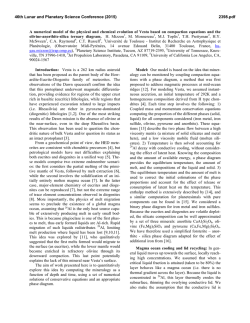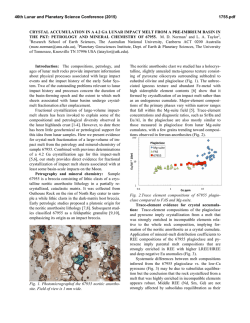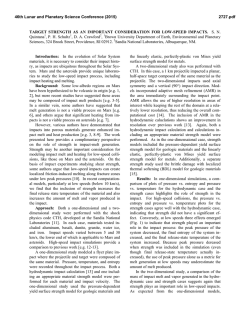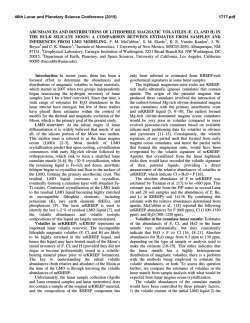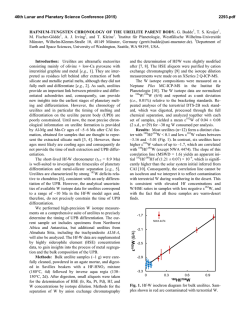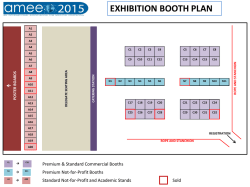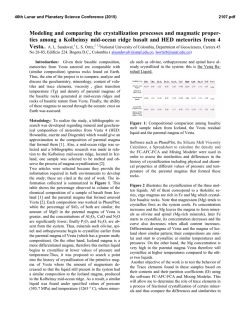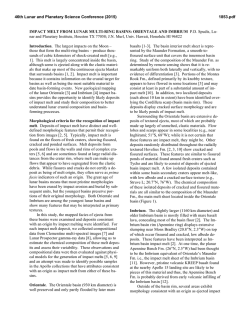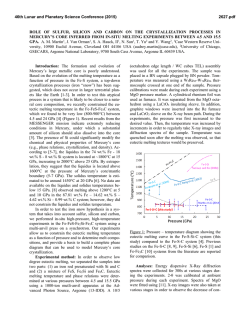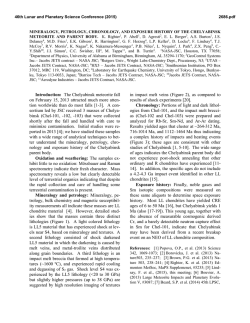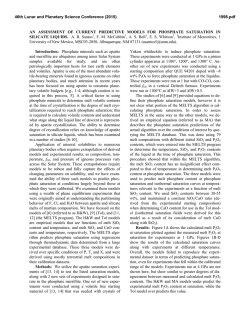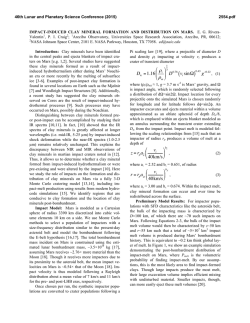
The Role of Melt Percolation on Differentiation of Lunar Magma Ocean
46th Lunar and Planetary Science Conference (2015) 2381.pdf THE ROLE OF MELT PERCOLATION ON DIFFERENTIATION OF LUNAR MAGMA OCEAN A. Hori1 and H. Nagahara2, 1-2Dept. Earth Planet. Sci., The Univ. Tokyo, 7-3-1 Hongo, Tokyo 113-0033, Japan 1 ([email protected]) Introduction: The Moon preserves the records of early geologic events on its surface due to the small size and the absence of atmosphere and ocean. The origin and evolution of the Moon are fundamental to understand the initial evolution of terrestrial planets and the formation of the Earth-Moon system [1]. The lunar crust and mantle are thought to have formed by fractional differentiation during cooling of the whole scale lunar magma ocean (LMO) (e.g., [2]). According to many previous studies about differentiation of LMO (e.g., [2]-[5]), it has been widely accepted that olivine crystallized at first to form a cumulate layer overlying the core, of which chemical composition successively changed to Fe-richer one. Orthopyroxene followed olivine, though the density of coexisting melt is still light enough to move upward. Once plagioclase appeared and floated to form a crust, the melt composition became heavy, which finally crystallized clinopyroxene and ilmenite-rich residues, with high concentrations of incompatible radioactive elements. Hess and Parmentier [6] discussed gravitational instability of this heavy layer and proposed a mantle overturn model, which well explains the source for high-TiO2 mare basalts erupted several hundred millions years later. However, the role of percolation process was not evaluated, which should have significant effects on the density profile during the LMO differentiation and subsequently on the internal structure and later evolution of the Moon, specifically time scale of density instability to overturn. Purpose: The present study aims to evaluate the percolation process that controlled the development of density instability during the LMO differentiation by thermodynamic and fluid dynamic modeling. Model: At first, bulk silicate Moon composition is assumed, which was obtained by [5], in order to satisfy the fluid dynamic conditions for the formation of the anorthosite crust with the thickness of 53km. The composition is 43.6 wt% SiO2, 36.6 MgO, 4.26 Al2O3, 3.39 CaO, and 11.8 FeO. Then, equilibrium crystallization was calculated for the melt with the MELTS or pMELTS code [7] at the pressure corresponding to the middle depth of the LMO. The initial LMO depth is assumed to be 1000km. Crystals were separated from the convective magma ocean when the fraction of crystal vol.% reached a critical value X, which varied as a parameter from 10 to 40. The fraction of trapped melt, the porosity of cumulate layer, vol.% is another pa- rameter, which varied from 25 to 50 (stated below). The chemical composition of the trapped melt is assumed not to change with time. Finally, the chemical composition and depth of the residual LMO was calculated by converting the volume of the separated minerals to the thickness of the cumulate layer. The same procedures were repeated until the total crystal fraction reaches 90 vol.%. The time scale for instability of the overlying melt above the cumulate layer due to the increase in the melt density by differentiation was evaluated according to Riaz and Hesse [8], which is shown as follows, φµ 2 D tC = 146 2 ( KΔρ g) (1) , where is porosity, is viscosity, K is permeability, Δρ is density difference between LMO and trapped melt, and D is the diffusion coefficient. The density and viscosity parameters are obtained by the (p)MELTS calculation. For D, diffusion coefficient of Fe2+ is used in the present work, because Fe2+ is essential to vary melt density. The value by [9] is applied. 2 Permeability is shown as K = d φ n with 2 ≤ n ≤ 3 , b where d is grain size of minerals and b is a geometrical constant. n is obtained to be 2 for <0.03 and 3 for > 0.03 for a melt-solid system by [10], and b is obtained to be 104 for n=2 and 103 for n=3 by [11]. Grain size, d, in the LMO is hard to know, and therefor, it varied as a parameter from 0.01 to 1.0 cm according to Solomatov and Stevenson [12]. The porosity (= trapped melt fraction), vol.%, is varied from 25 to 50 on the basis that the maximum packing crystal fraction is 0.639 for a uniform radius and 0.86 for a binary mixture with the ratio of 19 [13]. In summary, we have three parameters, X, , and d. Equation (1) was calculated with these three parameters for each step of differentiation calculation. Results: Figure 1 shows the change of the density and viscosity of LMO and the density of trapped melt with the progress of differentiation for X=10, =25, and d=1.0 cm. The density of trapped melt is constant for each step of differentiation calculation because the chemical composition of the trapped melt is assumed not to change with time. On the other hand, the density of LMO increases during crystallization from crystal fraction of zero to X, because the composition of the LMO successively changed to Fe-richer one. When the 46th Lunar and Planetary Science Conference (2015) solidification reaches ~73%, the density increases drastically, because plagioclase appeared to move upward to form the crust. The viscosity of the LMO also increases with differentiation because of the change of the composition of LMO. This tendency is also the case for other values of the three parameters. Figure 2 shows the percolation time, which is the time to arise instability between lighter trapped melt and the overlying heavier residual melt in the magma ocean body for the case of X=10%. The zigzag pattern comes from the density change of magma ocean during crystallization from the crystal fraction of zero to X, where the increase in the melt density lowers the percolation time. When the crystal fraction is reached the critical value X, the magma ocean comes back to crystal-free, the density difference becomes smaller, and the percolation time becomes longer. It is worth noting that the percolation time at the critical crystal fraction is approximately constant almost all through the LMO differentiation. Figure 2 shows that the porosity and specifically the grain size strongly affect the percolation time. The broken lines in Fig. 2 are for the case of d=0.01cm and the solid lines are for d=1.0cm. The percolation time varies by up to about two orders of magnitude for the variation of porosity by two times (compare red and green), whereas the percolation time varies by up to about 9 orders of magnitude for the variation of grain size by two orders of magnitude (compare red solid and broken lines). Discussions: Shearer [14] discussed that the duration of LMO crystallization is highly dependent on the size of the LMO and the nature and thermal conductivity of the early crust. The crystallization time of the LMO before anorthite crust formation is estimated to vary from 102 to less than 107 years (e.g.,[15],[16]). They also predicted total LMO crystallization time of 6 107 to 2 108 years for different thickness of the crust. Previous thermal models further suggested that the LMO crystallized very rapidly before anorthite crust formation and that the crystallization speed became smaller with thickening of the anorthite crust. Thus, the crystallization time of LMO is poorly constrained. Comparing the percolation time at the critical crystal fraction for each step of differentiation calculation and the duration of the whole LMO crystallization, we can conclude that the percolation time is much shorter than the crystallization time if the grain size is 1.0cm. If we apply the relationship between grain size and cooling rate of a magma ocean by [12], grain size tends to be larger with lowering cooling rate, which suggests larger grain size near the end of LMO crystallization. In summary, it is highly possible that the den- 2381.pdf sity instability caused repeated minor scale overturn of magma ocean and trapped melt during LMO differentiation, which would have resulted in the absence of density instability that caused large-scale overturn proposed by [6]. Reference: [1] Hartmann, W.K. and Davis, D.R. (1975) Icarus 24, 504-515. [2] Wood, J. A. et al. (1970) Proc. Apollo 1 Lunar Sci. Conf., 965. [3] Solomon, S.C. and Longhi, J. (1977) Proc. LSC 8, 583-599. [4] O’Neill and H. St C (1991) GCA 55, 1135-1157. [5] Sakai,R.,et al. (2014) Icarus 299, 45-56. [6] Hess, P. C. and Parmentier, E.M., (1995) EPSL 134, 501-514. [7] http://melts.ofmresearch.org/. [8] Riaz, A., et al. (2006) Journal of Fluid Mechanics 548, 87-111. [9] Zhang, Y., Ni, H and Chen, Y. (2010) Rev. Mineral. Geochem., 72, 311-408. [10] McKenzie, Dan. (1989) EPSL 95.1, 53-72. [11] Maaløe, Sven, and Åse Scheie. (1982) CMP 81, 350357. [12] Solomatov, V. S. and Stevenson, D. J. (1993) JGR Planets, 98(E3), 5407-5418. [13] Solomatov, V. S. and Stevenson, D. J. (1993) JGR Planets, 98, 5391-5406. [14] Shearer, C.K., et al. (2006) Rev. Mineral. Geochem. 60, 365-518. [15] Solomon, S. C., and J. Longhi. (1977) Proc. LPSC 8. 583-599. [16] Minear, J. W. (1980). Proc. LPSC 11, 1941-1955. Figure 1 Change of the density of the LMO and trapped melt and the viscosity of LMO with the progress of differentiation for X=10, =25,and d=1.0cm. Figure 2 Percolation time of LMO melt to interstitial melt by gravitational instability with the progress of differentiation.
© Copyright 2024
